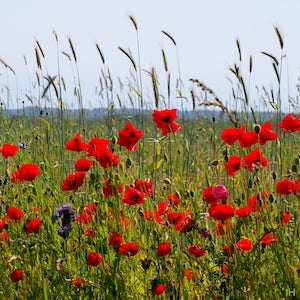Biodiversity is the variety of living plants and animals in a given area. It includes all types of plants, animals and microorganisms above and below ground.
Living beings are connected to each other. Think of the food pyramid. The greater the diversity, the more stable the whole.
Monoculture provides large plots of the same, which is then extra attractive to pests. With diversity there is also room for the natural enemies of pests.
Green manure
For a healthy soil life it is important that there are plants growing.
Our growers sow the land with a mixture of green manures as soon as possible after harvesting the organic bulbs. These are plants that benefit the fertility of the soil. All plants release substances into the soil through their roots. These substances serve as food for the micro life in the soil, and this creates a cooperation between good fungi and plants.
If given the opportunity to develop, these mycorrhizal fungi form networks that support and protect the plant in their essential growth processes. Each type of plant root releases different substances, each with its own positive properties.
Biodiversity in a green manure crop is therefore very beneficial for soil fertility. Our growers use a mixture of 11 different types. It contains, for example, grains that ensure deeper rooting, which results in a good soil structure. It also contains various legumes that capture nitrogen from the air and release it back into the soil at a later date. The mixture also contains various crucifers, which counteract harmful nematodes.
If the soil life is vital, the resistance in the soil is optimal and the disease pressure decreases.

Winter food
On fields where no organic bulbs will grow for a while (rotation field), a rich seed mixture is sown consisting of cereals, sunflowers and other seed-bearing crops.
The seeds are not harvested so that food is available for granivorous birds in winter.
We see large numbers of goldfinches, skylarks, finches, goalkeepers, meadow pipits, linnets and some pheasants.


Flowering field borders
We have sown flower seeds along a large part of our plots. In the summer, when our bulb flowers no longer bloom, this flower mixture blooms. Nectar and pollen from the flowers are an important source of food for bees and other insects. A delight for humans and insects.
The flowering field borders are the place where natural enemies of aphids can develop.


